There are a number of sections within this document. Using the links below you can skip to specific sections.
- Foreword
- Introduction
- National Context
- Regional Context
- Local Context
- Our current digital services
- Our digital vision
Need this page in another language?
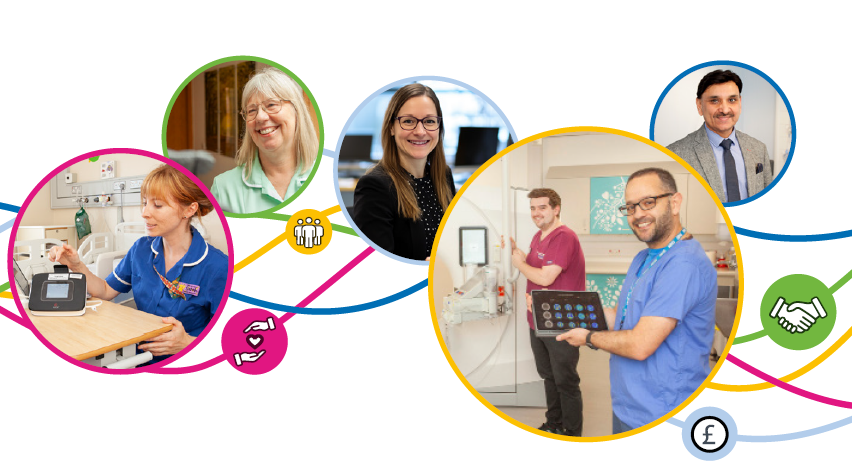
Foreword
 Dan Howard, Chief Information Officer
Dan Howard, Chief Information Officer
Digital technology is all around us and impacts almost every aspect of our lives.
We want Doncaster and Bassetlaw Teaching Hospitals to be the best Trust of its kind in the country, harnessing the power of modern technology.
This plan sets out how we will use digital innovation to improve the lives of our patients and colleagues as well as supporting the delivery of world class healthcare and research. It underpins our Trust strategy, supporting and improving the way our teams work by providing excellent systems and digital tools that give them more time to care. This includes making our services safer, more effective, and easier to access, all enhancing the overall experience of patients and colleagues alike.
This plan also sets out the cultural change needed to ensure every team is supported and equipped with the digital skills to make the most of our systems and services.
Digital has a key role to play in the innovation and research ambitions of the Trust. Through this Enabling Plan, we intend to develop our innovation and research relationships further.
Embedded throughout this enabling plan is our ambition to work collaboratively across organisational boundaries, knowing we can achieve far more when working together.
Our ambition is to transform healthcare, digitise information and build strong foundations. This document sets out our path to get there.
Our plan to transform healthcare, digitise information and build strong foundations
Despite advancements over recent years, there is a long way to go to realise the full digital potential of the NHS. During the lifetime of this enabling plan, we will continue to make improvements.
Starting with the essential foundations, we will implement WiFi and network upgrades across our major sites and provide thousands of new devices for colleagues. This will ensure our teams have reliable equipment that works well with minimal downtime. We will also ensure our digital services are resilient, reliable and fit for purpose.
Our Electronic Patient Record (EPR) Full Business Case is set for approval later in 2025 which will unlock funding for the system, for resources and for infrastructure. We are progressing readiness activities in terms of digital literacy, data quality improvements and clinical process redesign. Our new EPR will significantly accelerate our journey towards reducing our reliance on paper and improve our ability to communicate with patients and partners, while supporting system-wide clinical strategies to develop cross organisational pathways. Our new EPR will also significantly improve the user experience and streamline our support and training.
We have made significant progress with digital innovation, for example using Artificial Intelligence through the use Co-Pilot and Robotic Process Automation. We will be setting up a digital exemplar ward in early 2026 which will showcase new technology and ways of working to our teams, stakeholders and patients.
We will pilot new technologies such as ambient voice, and continue to push the boundaries of digital innovation so that our patients receive the best care possible and our Trust is recognised as a leader nationally for research and development.
We are keen that our colleagues have the right information to help make better clinical and operational decisions. Our ambition for analytics and data quality is to enhance information and reporting, aligning digital transformation with workforce resilience, operational efficiency and better patient outcomes.
We hope this document will be a guide for our digital working, innovation and collaboration and we look forward to the exciting realisation of our digital ambition in the years ahead.

National Context
In July 2025, the government published the NHS 10 Year Plan – Fit for the Future. The plan is a bold reimagining of healthcare in England, driven by the urgent need to modernise, make the NHS sustainable, respond to rising demand, address an ageing population, and improve patient outcomes.
The plan outlines three major shifts:
Hospital to Community: More care delivered locally – at home or in neighbourhood hubs.
Sickness to Prevention: Prioritising early intervention and healthy living to reduce long-term illness.
Analogue to Digital: Embracing AI and digital tools to streamline services and empower patients.
Analogue to Digital
The shift from analogue to digital is intended to take the NHS from the 20th century technological laggard it is today, to the 21st century leader it has the potential to be.
Despite the wider technological revolution in healthcare happening globally, the NHS remains a distinctly analogue service. We have not got the basics right: staff are still forced to put up with obsolete computer systems and paper records. Nor have we done enough to create the digital tools that will give patients real control over their healthcare in the future.
In the next decade, the NHS must not only catch-up: it must lead. We will harness the NHS’ unique advantages – world-leading data, procurement power and the means to deliver equal access – as we create the most digitally accessible health system in the world.
Fit for the Future: 10 Year Health Plan for England; Chapter 3: from analogue to digital – power in your hands.
Specific outcomes of the shift from analogue to digital outlined in the plan include:
- Ensuring rapid access for those in generally good health and freeing up physical access for those with the most complex needs, by moving ‘from bricks to clicks’.
- Giving patients real control over a single, secure and authoritative account of their data – a single patient record – to enable more co-ordinated, personalised and predictive care.
- Transforming the NHS App into a world-leading tool for patient access, empowerment and care planning.
- Using continuous monitoring to help make proactive management of patients the new normal, allowing clinicians to reach out at the first signs of deterioration to prevent an emergency admission to hospital.
- Building a ‘HealthStore’ to enable patients to access approved digital tools to manage or treat their conditions.
- Introducing single sign on for healthcare colleagues, and scaling the use of technology to reduce the burden of bureaucracy and administration, freeing up time to care and to focus on the patient.

Regional Context
The Trust has long maintained strong working relationships with our local partners. Our Digital Enabling Plan is fully aligned with the digital transformation strategy developed by the South Yorkshire Integrated Care Board (ICB) and Nottingham and Nottinghamshire Integrated Care Board (ICB).
Purpose: To work together to optimise our use of digital services and technologies, creating a sustainable landscape of core systems and tools to elevate our digital maturity and help people in South Yorkshire communicate, connect and engage with health and care services safely and with confidence.
Partnership Objectives:
- Provide inclusive digital and online services in South Yorkshire.
- Enable better information flow between care settings by prioritising convergence and interoperability.
- Work together to find efficiencies in a financially constrained environment, procuring scalable solutions.
- Optimise existing core systems and tools.
- Develop and deliver digitally mature services in a sustainable way.
Programmes:
- Digital Inclusion and Accessibility
- Shared Care Record
- Digital Primary Care
- Digitising Social Care
- Provider-led Digital Requirements
- Digital Workforce (via Digital Workforce and Skills Strategy)
Partnership Priorities: Digital Maturity, Artificial Intelligence, Technology Enabled Care, Sustainability, Clinical Safety, Research and Innovation, Benefits and Impact.
The strategy provides a framework for effective collaboration, supporting service delivery and patient engagement by enabling more confident use of digital services across our workforce and communities.
Our South Yorkshire and Bassetlaw Acute Federation is committed to digital convergence and has plans to join up care through better, shared use of information and technology. This
includes:
- Shared information through Electronic Patient Record (EPR) system. Implementation due to commence in February 2026.
Implementation is planned to begin in February 2026. - The Trust will be part of a programme to implement a new Laboratory Information Management System (LIMS), which will transform pathology services across South Yorkshire.
- The use of systems for storing and updating workforce records will be harmonised across the region, and we are also exploring digital convergence across electronic document management systems, cancer management systems and order communications systems.

Local Context
As a Trust, we have a role within the health and social care community to respond to the priorities of the local ‘place’ and regional Integrated Care Boards (ICBs) to meet local population needs. The Trust is a key stakeholder in the delivery of Place Plans for both Doncaster and Bassetlaw. As a Trust, we have a role within the health and social care community to respond to the priorities of the local ‘place’ and regional Integrated Care Boards (ICBs) to meet local population needs. The Trust is a key stakeholder in the delivery of Place Plans for both Doncaster and Bassetlaw.
Our digital plans also align to South Yorkshire ICB and Nottinghamshire ICB strategies, along with the South Yorkshire and Bassetlaw Acute Federation’s Clinical Strategy and the NHS Long term Plan.
Doncaster Place Plan
- Develop neighbourhood health services.
- Improve communication and promote initiatives that support personal wellbeing.
- Promote positive health strategies and campaigns.
- Raise awareness of, and provide support to access, local services.
- Increase activities for older people, and for those who are isolated or lonely.
- Promote the benefits of being active for mental health and wellbeing.
- Support access to apprenticeships and employment opportunities.
- Raise awareness of, and publicise, community mental health services.
Bassetlaw Place Plan
- Provide integrated support for the wellbeing of Bassetlaw citizens, with community-based, person-centred approaches covering welfare, housing, social activities, employment and health.
- Develop a joint transport strategy to better understand community needs, make best use of collective resources, and improve efficiency and experience.
- Deliver the right support at the right time through integrated health and care pathways in both community and acute settings.
- Strengthen communications and engagement through shared approaches, putting Bassetlaw people at the heart of service design.
- Create sustainable and effective services, supported by an integrated workforce, digital and estates infrastructure, and making the best use of the Bassetlaw purse.
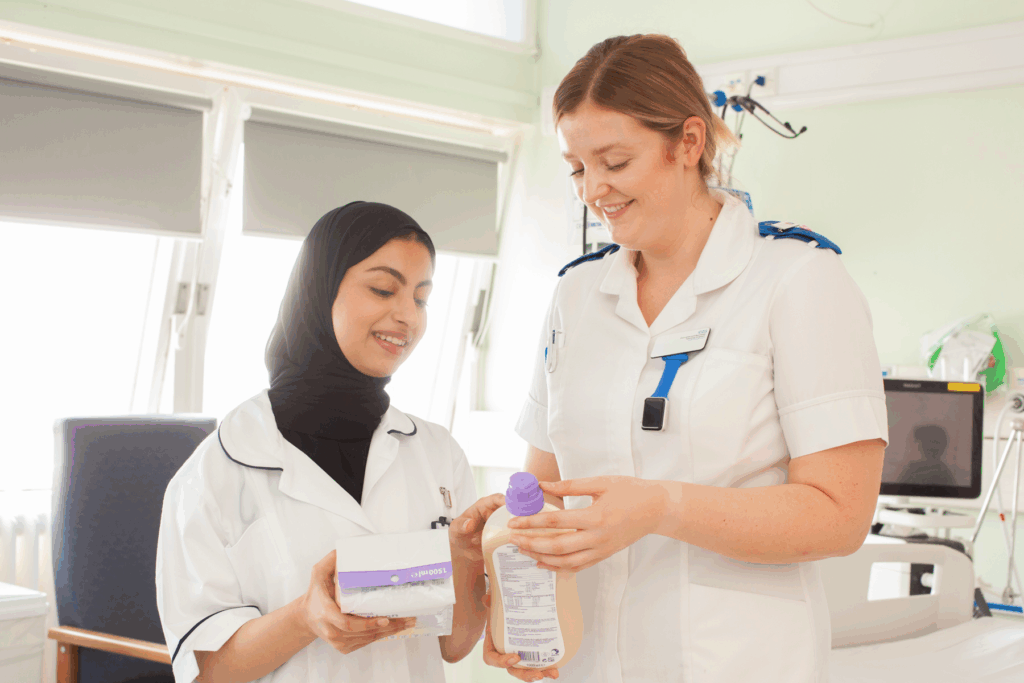
Our current digital services
The Digital Maturity Assessment helps providers and integrated care systems across England to understand their level of digital maturity by identifying key strengths and gaps in the provision of digital services.
In the most recent NHS Digital Maturity Assessment in July 2025, DBTH scored 2.4 which was slightly below average against our peers within the region and across England. Our ambition is to increase the ‘ensure smart foundations’ and ‘empower people’ pillars which will significantly increase our overall score in future assessments.
We currently have over 150 IT systems across the Trust, many of which are not connected. This makes it difficult for clinicians to see a complete picture of a patient’s care, slowing down decisions and increasing the risk of missed information.
Our new Electronic Patient Record (EPR) will replace these fragmented systems with a single, robust platform. Clinicians will have timely access to accurate information at the point of care, supporting safer clinical decisions, reducing duplication, and freeing up more time for direct patient care. Patients will benefit from more joined-up, consistent, and efficient care across the Trust.
We have made significant improvements in recent years, including:
- infrastructure improvements
- embedding our current EPR
- use of the shared electronic record systems across South Yorkshire and Nottinghamshire
- increased use of dashboards for information management
- a new Radiology Information Management system
- a new Audiology system
- a new digital paging system
Developing the Digital Enabling Plan: Engagement with colleagues and partners
In developing this Enabling Plan we engaged widely through a variety of means:
- All staff survey
- Workshop with senior leaders within the Trust
- Discussion with system partners such as other Trusts, Place based groups and ICBs
- Feedback from Trust staff groups such as Nursing, Midwifery, and Allied Health Professionals
- Feedback from a variety of patient groups
Senior leaders and colleagues identified a range of ways digital technology can support them to improve patient care, experience and enhance productivity and team satisfaction:
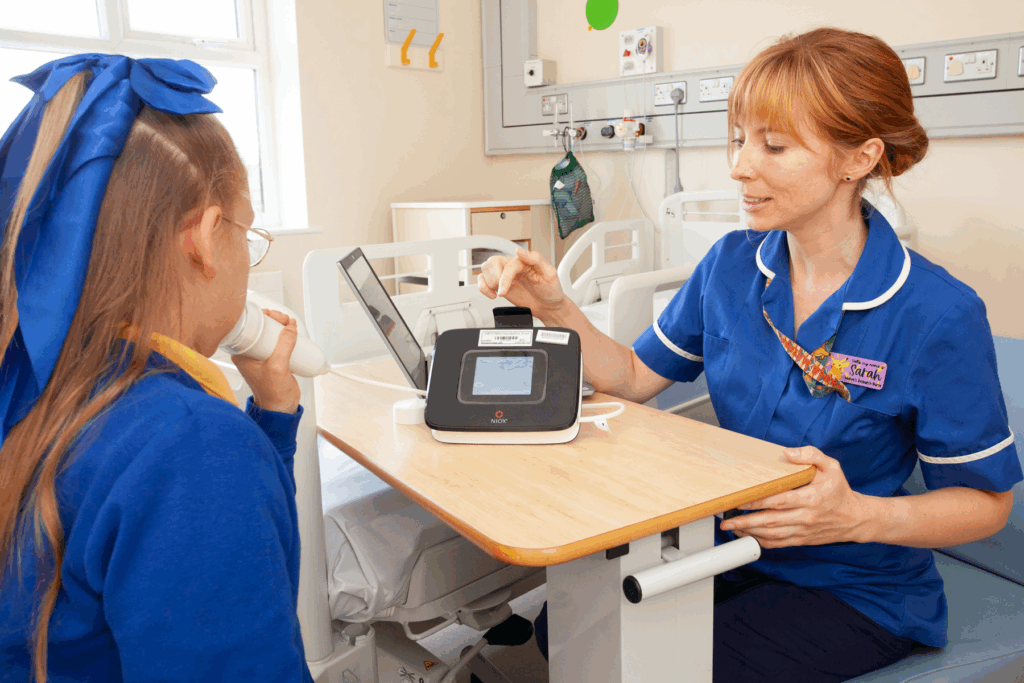
Our digital vision
We will deliver digitally enabled services that provide exceptional care, quality and safety for our patients, built on a single view of information for our clinicians, with collaboration at the core. To achieve this vision, we will focus on the following themes:
Implementation of a new Electronic Patient Record
From February 2026, we will begin implementing our new EPR, based on the Oracle Health platform introduced at Sheffield Teaching Hospitals, with go-live planned for October 2027. We will also replace other major supporting systems as needed. Collectively these will provide easy to use systems giving access to accurate up to date information at any place and time.
Digital Innovation
We will implement safe, evidence-based digital innovations, including the use of Artificial Intelligence (AI) and machine learning to improve clinical outcomes, patient experience, and operational productivity.
Analytics & Data Quality
We will become a data driven and information rich Trust, using analytics to shape current and future clinical care and to support clinicians to make excellent clinical decisions. We will integrate new technology, using automation, and applying standards and governance to improve data quality.
Digital Foundations
We will improve infrastructure such as WiFi, cyber security and provide user technology which supports an amazing user experience.
Digital Workforce, Engagement & Communication
We will introduce a digital-first culture, ensuring our workforce has the skills to make the most of digital, data and technology.
Digital Principles
- People first: We think about solutions from a user’s perspective – whether that is our colleagues, our patients or their families/carers.
- Simplicity: The best digital systems and solutions are intuitive, simple and make sense to users. We will do things once across the Trust, taking every opportunity to provide solutions, processes, suggestions, and learning once, for all colleagues across all sites.
- Working in an agile way: We work flexibly and use agile principles that allow us to make rapid progress, whilst remaining flexible when needs change.
- Communicating and engaging throughout: We engage and involve patients, colleagues and partners in developing and implementing solutions.
Our Digital Aspiration
How we will measure our progress:
Digital Maturity Assessment: Achieve a score of 4 out of 5 or higher, reflecting national standards for digital maturity.
Healthcare Information and Management Systems Society (HIMSS) Electronic Medical Records (EMR) Accreditation: Attain Level 7, demonstrating how effectively we are using our Electronic Patient Record (EPR) to support patients and clinicians.
Data Security and Protection Toolkit: Maintain a consistent ‘Standards Met’ rating, including cyber security assessments.
Excellence in Informatics Accreditation: Secure accreditation through the Skills Development Network.
Telephony Benchmarking: Compare and improve our services against other local Trusts with similar patient populations.
Sustainable Procurement: Ensure all eligible digital purchasing is completed through the North of England Commercial Procurement Collaborative, delivering best value for money while embedding sustainable procurement and social value.
We will know we have achieved this ambition when…
Patients say:
- “I can easily access my information from my device.”
- “I know my information is safe.”
- “I can make appointments using my device.”
- “My care can be monitored from home.”
All colleagues say:
- “The software and device I have helps me work better.”
- “The systems I use are easy to access.”
- “I feel confident using Trust IT systems.”
- “I have access to all of the training I need.”
- “When I have an IT problem, it is fixed promptly.”
Managers say:
- “I understand the performance of my team.”
- “I have access to the information I need to influence decision making.”
- “I trust the analysis and performance information I have and can answer queries on the data.”
Clinicians say:
- “I can provide better care because of the systems and IT equipment I have.”
- “I can easily view patient records, wherever I am.”
- “I feel supported by digital when using systems and IT equipment.”
Timeline of ambitions
| 2025 | 2026 | 2027 | 2028 / 9 |
|---|---|---|---|
| April: EPR foundational network infrastructure work began | February: EPR Implementation Starts | July: Trust-wide WiFi enhancement complete | December: HIMSS Digital Maturity Re-assessment (2028) |
| June: Montagu Hospital network and Wifi refresh completed | March: Federated Data Platform rolled out | September: New hardware roll out to support EPR | November: LIMS implementation Go-Live (2029) |
| December: EPR As-IS process mapping complete Bassetlaw Hospital network and Wifi refresh to be completed | June: Analytics “Business Partners” established | October: EPR Implementation Go Live, including integrated Electronic Prescribing and Medicines Administration (EPMA) | December: HIMSS Digital Maturity Re-assessment to achieve Level 7 (2029) |
| July: Business Rules and Flags Review | December: Cloud Computing for Data | ||
| August: HIMSS Digital Maturity Assessment | |||
| October: Microsoft Office 365 Co-Pilot AI rolled out | |||
| December: Pre-EPR Data Cleansing including, use of AI for targeted data validation Excellence in Informatics Accreditation Doncaster Royal Infirmary network and Wifi refresh to be completed |

Electronic Patient Record
We are introducing a new Electronic Patient Record (EPR) system across our Trust by late 2027, replacing many of our existing systems with a single, more efficient way of working.
In the lead-up to implementation, we will focus on improving digital literacy and data quality, helping colleagues feel confident with the new system and ensuring a seamless migration of information. As we go live, every colleague will receive the right training and support, the system will be configured to work in the best possible way, and clinical safety will remain our highest priority.
Together, these steps will make sure the transition is smooth and that everyone feels supported throughout the change.
About the new system
The EPR, will be a shared version of the Oracle Health system used by Sheffield Teaching Hospitals and will go live in October 2027.
New ways of working enabled by the new EPR will free up time for care, improve record-keeping, and make accessing patient information faster and more secure. It will also help us work more closely with colleagues across the region, ensuring more joined-up care for patients.
Implementation will begin in February 2026.
What key systems are we replacing?
- Patient Administration System (PAS): The core system used for patient registration, appointments, and admissions.
- Symphony: The system used within urgent and emergency care.
- ICE: Used for requesting tests and viewing results.
- WellSky: Electronic prescribing and medicines administration system (Pharmacy Stock Control System will be retained)
- Bluespier: Theatre management system.
- Paper records: used widely across the Trust
About ORBIT
The programme, called ORBIT – One Record, Better Information & Treatment – has been named by colleagues and reflects our ambition to transform care by replacing multiple systems with a single, more efficient and user-friendly platform.
ORBIT will be a clinically led programme, with Acting Chief Medical Officer Nick Mallaband serving as the Senior Responsible Officer. A robust change and readiness strategy will guide the programme, creating a shared endeavour that brings together the knowledge, skills and experience of the ORBIT team, clinical and operational colleagues at all levels, and Oracle Health.
This approach will ensure Trust teams are well-prepared and supported to adopt new ways of working.
[insert logo image when chosen]
Programme Timeline
| Date | Phase | Duration | Actions |
|---|---|---|---|
| February 2026 | Phase 1: Start Up | 10 weeks | Project Start-Up Activities Client Readiness |
| Phase 2: Plan | 6 weeks | Enterprise Standards Validation Change Management Workshop |
|
| Phase 3: Align | 8 weeks | Current State Review CSR Leadership Debrief |
|
| Phase 4: Engage | 62 weeks | Future State Review Data Collection Localisation Future State Validation Testing Data Migration Training |
|
| Phase 5: Activate | 3 weeks | Go Live Preparation Dress Rehearsals |
|
| October 2027 | GO LIVE | 18 weeks | |
| Phase 6: Measure | Health Check (Initial) Value Assessment |
Our ambitions
- Seamless access to patient records – with unified records all in one place, enabling patient care and safety.
- Reduced paper-based practices – moving paper-based processes to easy-to-use digital platforms.
- Patient-held and accessible records – providing patients with the power to monitor their healthcare data.
- User experience – developing user-friendly solutions that cater for all, regardless of the level of digital literacy.
- Improved decision making – longitudinal record and clinical decision support guides colleagues and standardises workflows.
- Greater efficiency – streamlined practice releases time to care, supports clinical audit, SNOMED CT and PRSB standards, improves hospital reputation and professionalises record keeping.
Measuring our improvement
Within 1 year (by December 2026)
- EPR Full Business Case approved by NHS England.
- Upgraded Maternity system.
- All four Federated Data Platform ‘products’ in use.
- Reduction in 10% of paper in use across the Trust.
- 5% reduction in the number of clinical systems in use.
- Reduction in the use of the current system (Nervecentre) and a clinically designed EPR system.
Within 3 years (by December 2028)
- Healthcare Information and Management Systems Society (HIMSS) Electronic Medical Records (EMR) assessment – Level 7.
- LIMS system replaced.
- PACS system replaced.
- Reduction in 80% of paper in use across the Trust.
- 20% reduction in the number of clinical systems in use.
- Promotion and colleagues satisfaction of the new EPR system. Improved efficiencies and staff wellbeing.
Within 5 years (by December 2030)
- Reduction in 90% of paper in use across the Trust.
- 25% reduction in the number of clinical systems in use.
- Full digitally mature clinical workforce. National exemplars in digital practice.

Digital Innovation
The urgency for innovation has never been greater. Our ambition is to be a testbed for faster adoption of safe, evidence-based digital innovations to improve clinical outcomes, patient experience, and operational productivity.
We will translate national strategy into local delivery, adopting what works quickly, generating real-world evidence for emerging technologies, and scaling only those tools that are safe, value-adding, and equitable. This approach will ensure DBTH remains aligned with NHS England’s priorities for innovation while addressing local health needs.
The NHS is transitioning toward a unified, evidence-led approach to digital transformation, driven by the Accelerated Access Collaborative (AAC), National Institute for Health and Care Excellence’s (NICE) evidence framework standards for digital health, and NHS England’s Digital Technology Assessment Criteria (DTAC). These frameworks provide clear guidance on safety, clinical efficacy, and interoperability, removing unnecessary duplication and enabling Trusts like DBTH to adopt proven technologies at pace. By anchoring all digital decisions to these national standards, DBTH can reduce governance complexity and accelerate the delivery of tangible benefits for patients and colleagues.
Artificial Intelligence (AI)
A key to achieving our ambitions is the adoption of a robust Artificial Intelligence (AI) Policy reflecting NHS guidance and regulatory requirements. All AI solutions introduced within DBTH will undergo rigorous governance, ensuring they comply with DTAC and NICE evidence standards.
This includes clinical safety checks, data protection impact assessments, and adherence to DCB0129/0160 clinical risk management protocols.
For any AI tool deployed, explainability, bias monitoring, and transparency will be mandated, ensuring decisions remain safe, fair, and accountable. Generative AI will be introduced cautiously for defined, low-risk tasks -such as summarising documents or drafting patient information – with strict controls to ensure human oversight and auditability.
Our AI policy also establishes post-deployment assurance, requiring continuous monitoring for performance, safety, and equity. Each solution will be added to a benefits and safety register, supported by sunset clauses to decommission tools that fail to deliver value. By embedding fairness reviews and ensuring compliance with accessibility standards, DBTH will mitigate the risk of digital exclusion and inequity in care delivery.
To align with the NHS England strategy on innovation, DBTH will work closely with the NHS Innovation Service, providing a clear entry point for external innovators and colleague-led ideas.
From 2025 to 2028, DBTH will prioritise four key areas:
- AI-enabled imaging and diagnostics to reduce backlog and turnaround times
- Automation to streamline administrative processes and free up clinical time
- Virtual care solutions for long-term condition management
- Commitment to equity by design, ensuring all innovations meet usability and accessibility requirements.
These initiatives will be underpinned by open standards, interoperable platforms, and strong supplier relationships to avoid fragmentation and support seamless integration across systems.
Digital Academy
People and skills will be central to this plan. DBTH will invest in digital literacy training through a Digital Academy, covering AI fundamentals, prompt safety, and evaluation methods. By leveraging NHS AI resources and national communities of practice, we will build confidence and competence among clinicians and operational colleagues, ensuring successful adoption and cultural readiness for innovation.
DBTH will embed transparency and accountability into its innovation process. Each initiative will have measurable outcomes – covering safety, clinical impact, operational efficiency, and equity – and findings will be shared publicly through short “innovation notes.”
This aligns with NICE’s real-world evidence standards and supports the wider NHS ambition to scale what works across systems.
By combining rigorous governance, proactive adoption, and a culture of learning, DBTH’s Digital Enabling Plan will ensure that innovation translates into meaningful improvements for patients, clinicians, and the health system.
Measuring our improvement
Within 1 year (by December 2026)
- System in place to capture digital innovation ideas from colleagues.
- Working group in place to ensure the design, implementation and deployment of systems improve clinical workflows – encouraging clinically led co-design.
- Pilot projects launched, increasing the use of AI within clinical settings.
Within 3 years (by December 2028)
- At least two digital innovation events hosted at DBTH.
- Of patient groups suitable for virtual monitoring, 80% are utilising the technology.
- NHS App being used as the single patient front door.
- Clinicians have embedded digital systems/ tools into routine practice to improve care and aid decision making – reducing variance in care.
- Patients experience more seamless, proactive care.
Within 5 years (by December 2030)
- Patients experience fully joined up care through intuitive digital systems.
- Clinicians spend more time providing direct care through supported digital tools, such as AI.

Analytics and Data Quality
The Trust’s ambition for analytics and data quality is to enhance information and reporting, aligning digital transformation with workforce resilience, operational
efficiency and better patient outcomes.
By 2029, we will deliver a modernised, efficient, and responsive digital infrastructure, underpinned by a skilled workforce and robust governance. Clinical coding will be fully brought in-house with enhanced quality and cost-efficiency; data quality will be at national best practice levels; and users across the Trust will benefit from streamlined access to reliable, actionable insights.
Achieving this ambition will ensure the Trust remains agile, future-ready, compliant with national standards. This ambition is founded on five pillars:
- Strengthening clinical coding
- Technological integration
- Improving data quality
- Advancing data development practices
- Developing a resilient, right-sized workforce
Strengthening clinical coding
A strategic shift is planned to bring previously outsourced coding services back in-house. This move is anticipated to be both cost-effective and quality-enhancing.
It will be supported by automation tools such as auto-coding for simple cases. By automating routine tasks, skilled coders can be re-deployed to more complex cases where human expertise is critical. This supports broader efficiency goals while safeguarding the quality and accuracy of coded clinical data. Training and implementation of upcoming standards such as ICD-11 are also core components, ensuring the team remains compliant and future-proof.
Technological integration
Leveraging Office 365 tools – including Copilot – will drive efficiency in administrative tasks, collaboration, and data handling across all digital functions. Additionally, further investment in AI-based validation tools is planned to support DQA, allowing automation to handle high-volume validation tasks while reserving human input for more complex areas. Embedding DQA colleagues within clinical divisions will increase visibility and enhance collaboration, ensuring that data issues are addressed promptly and in context.
Improving data quality
Preparation for the new Electronic Patient Record (EPR) system is a strategic priority for the Trust. Pre-EPR data cleansing using automated tools is underway to ensure high levels of accuracy and readiness. Cloud computing will be explored to modernise the Trust’s data analytics infrastructure. Linked to this is the implementation of DevOps processes, which will
enhance project delivery by improving deployment management, version control, and auditing of changes in data environments.
The Trust will continue to benchmark clinical coding quality against national averages, supporting better coding depth and income assurance. Maintaining the highest levels of DSPT audit performance remains a key objective, reinforcing the Trust’s reputation for secure and compliant data practices. In DQA, the goal is to place the Trust within the top 25% nationally for data quality, leveraging the SUS DQ Dashboards and business intelligence tools to monitor and improve performance.
Advancing data development practices
A more robust data architecture will be implemented to minimise issues such as system locks and blocks. A formal archiving policy will be established to determine which data is retained for
reporting and which can be archived or removed. The introduction of a Digital Portal will centralise access to key resources – such as reports, forms, and system status updates -helping end-users engage more effectively with digital tools and services.
Improving user adoption and engagement is a key challenge to be addressed. A digital catalogue of available reports will be developed to reduce duplication and increase transparency of data and
insights available to better inform decisions-making. Additionally, the ongoing development of business rules and clinical flags will ensure that as reporting tools evolve, data integrity and consistency are maintained.
The Trust will invest in advancing the analytical capabilities by embracing Data Science as a key driver for identifying areas for improvement and risk by utilising the industry standard software. This will allow scenario-based data modelling to be created to ensure the Trust has the highest level of insight to deliver on challenging national standards.
Developing a resilient, right-sized workforce
Recognising an aging workforce and the importance of retaining skilled colleagues within the analytics and data teams, we will prioritise targeted upskilling, appropriate training in the latest relevant technology, flexible workforce planning, and enhanced wellbeing initiatives. These will include a further rollout of hybrid and flexible working practices, which have become increasingly viable with the continued digitisation of health records. These changes are expected to improve colleague satisfaction, reduce turnover, and enhance the Trust’s competitiveness as an employer of choice.
To create the conditions to achieve our ambitions, plans will be underpinned by strong governance, communication, and change management. Digital champions and divisional leads will support implementation at the local level, while structured project oversight and regular reviews will ensure progress is tracked and risks managed. Colleague engagement, user feedback, and transparent reporting will be used throughout, to ensure that digital initiatives deliver real value on the ground.
Measuring our improvement
Within 1 year (by December 2026)
- Upskilling and Workforce Planning – Resilient, right sized workforce
- Hybrid and Flexible Working – Reduced turnover, improved morale
- Embed specific roles in Divisions – Increased engagement and faster issue
- Increased Visibility of Teams – Greater recognition and cross-functional trust
- Roll out of the Federated Data Platform – Improved performance and reporting consistency
- Leverage Office 365 CoPilot – Streamlined admin and analysis
- International Classification of Diseases (ICD) -11 Implementation – Compliance and Accuracy
- Business Rules and Flags – Consistent, trusted service
- Digital Report Catalogue – Streamlined access to insights
- Improve Dashboard Adoption – Better operational decisions, less duplication
- Digital Portal – Centralised info hub for digital ops
- Using new technologies and consistent processes in Clinical Coding to reduce
Within 3 years (by December 2028)
- Auto-coding & Validation Tools – Higher productivity and cost savings
- AI in DQA – Reduced manual effort, better data quality
- Cloud Computing for Data – Industry standard data environment
- Pre-EPR Data Cleansing – Reliable transition to EPR
- DevOps for Data Development – More stable, transparent change management
- Robust Data Structure – Faster, more reliable reporting systems
Within 5 years (by December 2030)
- National Clinical Coding Benchmarking – Meet/exceed national average depth (ongoing throughout lifecycle of strategy)
- DSPT Compliance – Trust reputation and assurance (ongoing throughout lifecycle of strategy)

Digital Foundations
In collaboration with suppliers and regional healthcare partners, we aim to ensure that colleagues and patients can access the information they need, whenever and wherever it’s required. By harnessing digital healthcare tools and high-quality, complete data, we will streamline processes, automate routine tasks, support better clinical decision-making, and reduce risk.
In collaboration with suppliers and regional healthcare partners, we aim to ensure that colleagues and patients can access the information they need, whenever and wherever it’s required. By harnessing digital healthcare tools and high-quality, complete data, we will streamline processes, automate routine tasks, support better clinical decision-making, and reduce risk.
In preparation for the upcoming Electronic Patient Record (EPR) and a digital-first approach to care – and in line with the What Good Looks Like framework (Smart Foundations, Improving Care, Empowering Citizens, and Safe Practice) – the Trust’s Digital Service is delivering essential technology improvements to support the successful implementation of the new core system, alongside integration with existing systems and medical devices, by the end of 2027.
The resulting combination of advanced software and modern hardware will deliver efficient and safe access to a comprehensive patient health information record and associated electronic workflows, replacing and surpassing current systems capabilities and paper-based records and processes.
We will provide and enable a simple, but highly integrated digital ecosystem to facilitate clinician-driven innovation, supported by the rapid and safe flow of health information essential to effective coordination and continuity of care.
To achieve our goal, we will focus on:
- Digital Maturity
- Integration and Interoperability
- Digital Security & Patient Safety practices
Digital Maturity
Building upon the Trust’s basic electronic and paper records and timeworn hardware, we will deliver a wholly integrated digital-first environment. The use of modern high-quality, reliable, technology will enable and enhance efficient operations and excellent clinical services. Using HIMSS digital maturity assessments, our ambition is to progress to the highest rating (Level 7) by the end of 2029, having achieved Level 5 following the successful implementation of the new EPR in October 2027.
Integration and Interoperability
Ensure the Trust’s systems and medical devices can reliably and securely share information within a single, comprehensive electronic record. This will give colleagues access to up-to-date patient information across all care settings within the Trust and the wider region, enabling seamless, coordinated care.
Digital Security and Patient Safety
We will reinforce and develop the Trust’s protection against cyber-attacks and data security or systems-based incidents. We will deploy supporting defensive, fault resilience and high availability technologies within our solution architecture. These measures will protect our essential clinical services and the information entrusted to us by our patients, in line with the NSH ‘CAF-aligned DSPT’ assurance framework and the Department of Health and Social Care’s ‘Cyber Security Strategy for health and social care: 2023 to 2030’.
To achieve our aims, we will invest in:
| Modern, fit for purpose end-user devices | New laptops, desktops, large monitors, computers on wheels and wall-mounted equipment and displays. |
| Healthcare-specific mobile devices | Designed to support eObs and other clinical workflows. |
| Fast and reliable networking and Wifi | Enabling rapid access where and when colleagues need it. |
| High availability and cyber security improvements | Assuring a resilient and safe approach to EPR operations, with a combination of services hosted in the cloud, as hybrid, or locally, as best fits the Trust’s needs. |
| Replacement and fit-for-purpose IT Service Desk and IT Service Management solution | Supporting teams and services aligned with the ‘Information Technology Infrastructure Library’ (ITIL) framework and pursuing NHS ‘Service Desk Institute’ (SDI) accreditation for best practice, including effective incident and problem management, systems, network, and asset performance monitoring in real time, secure single sign-on across all the Trust’s applications, AI chat functionality for IT issues and service requests, and user self-service for password resets, access provisioning, rapid replacement of faulty hardware, amongst other expected service improvements. |
| Leveraging national investment in NHS 365 | This includes reducing costs for locally procured software, servers, and storage by adopting progressive web app (PWA) versions of Microsoft Office and migrating files and data to 365 via OneDrive and SharePoint. These changes will support more efficient online collaboration while minimising duplicated email attachments and the risks of multiple document versions in circulation. |
| Participating in the NHSE sponsored national pilot of Copilot | AI software integrated with NHS 365, from which evidence of the potential for AI to improve efficiencies and reduce costs at the Trust is already emerging. |
Measuring our improvement
Within 1 year (by December 2026)
- Maintaining ‘Standards Met’ assessment for the CA_DSP Toolkit.
- 25% reduction of number of service desk calls that could have been resolved using self-help (or are first time fixes over the phone).
- We will extend our service desk support hours to reflect demand.
- No more than 1% of service desk calls for incident response outstanding without a resolution after 31 days of the call being made.
- We will monitor our staff survey results to ensure improvement in digital confidence, colleagues satisfaction and useability.
- Collaborate within the region to provide the foundations of shared digital resources.
Within 3 years (by December 2028)
- Service Desk accreditation.
- 50% reduction of number of service desk calls that could have been resolved using self-help (or are first time fixes over the phone).
- 50% reduction in number of calls to the service desk for poor Wi-Fi and slow connectivity.
- Single sign-on extended to xx% of the workforce. Ensure we maintain the ‘Educate, Train, Listen’ approach to support achieving HIMSS Level 7.
- Co-designed patient-facing solutions (apps, portals, wearables) embedded in routine care.
Within 5 years (by December 2030)
- 75% reduction of number of service desk calls that could have been resolved using self-help (or are first time fixes over the phone).
- 75% reduction in number of calls to the service desk for poor Wi-Fi and slow connectivity.
- Have a fully mature, digital clinical workforce.
- Full interoperability between hospital, community, and primary care systems.

Digital Workforce, Engagement and Culture
We will continue to develop and support our highly skilled and engaged Digital team, which is recognised as an effective and valued partner to the Trust’s clinical service areas.
Our Digital team will support and enable a digitally empowered and confident workforce in the wider Trust, providing colleagues with a great digital experience with effective software and hardware that works in the way they need to provide excellent clinical services.
In alignment with the ‘What Good Looks Like’ framework (Supporting People), we will invest in digital skills and capabilities to support the adoption and effective use of new software and hardware technologies by the Trust’s workforce.
Our teams will receive training and education to support digital transformation and adoption of the new EPR, maturing NHS 365 implementation, and associated changes to workflows in the transition from paper to digital. They will have opportunities to contribute to current state process mapping and designing and producing the future digital state, including increased use of online collaboration within the NHS 365 platform, artificial intelligence (AI), and clinical decision support (CDS) enabled tools.
With digitally enabled workflows and modern, reliable, high performing hardware and software integrated with medical equipment, the Trust can expect an environment that supports flexible working and reduction in workforce pressures and increases time for direct patient care and other value adding services.
With the EPR at the core of all patient interactions, our workforce will only need to enter information once. The system
will fully integrate with existing platforms to maximise its benefits, giving teams access to a single, comprehensive patient record and task automation across all sites – and ultimately across the region. This will enable seamless collaboration between sites and providers, support remote working, and drive continuous improvement in patient services.
We will implement a cyber-security strategy that strengthens our culture of data security across the Trust. By aligning all colleagues towards the same goals, we will enhance our ability to detect and respond to incidents effectively, protecting our systems, data, and the essential clinical services that depend on them.
Measuring our improvement
Within 1 year (by December 2026)
- All research projects have digital involvement.
- Digital literacy benchmarked with agreed action plan.
- Introduction of the Cyber Security Strategy.
- Digital Champions network established within Divisions with at least five in each Division.
- Review of the current pre-EPR Information Asset Register.
- Provide a suit of additional role-based Information Governance & Cyber based learning packages for all colleagues through Divisional Information Governance & Cyber Champions.
- Provide robust information governance, cyber and information security practices to maintain, enhance, and to keep DBTH safe from cyber and data exploitation.
- Improve coordination on our adherence to information and security standards by strengthening the collaboration of Information Governance (IG), Clinical Safety Reporting and Digital Services Teams.
- We will adhere to CAF based Information Governance & Cyber Security standards, to further ensure the availability, security and integrity of information, acknowledging the complexities of access to records, particularly for vulnerable groups.
- Improve adherence to clinical safety assurance for all digital systems within the organisation. Act as clinical lead in EPR design workshops, ensuring nursing and AHP workflows are fully represented.
- Define clinical safety standards for nursing documentation, medication management, and care planning.
Within 3 years (by December 2028)
- Online collaboration is normal for colleagues and emailing attachments has fallen by 80%.
- Digital literacy programme recognised nationally as an exemplar (e.g. awards, national body recognition).
- Development and Implementation of a post-EPR Smart Information Systems Asset Register accessible to all digital colleagues through a ‘role-based’ control process.
- Provide focussed access to additional learning packages through ESR.
- Achieve full compliance with the objectives and principles of the CAF_DSP Toolkit year on year. Set up a bespoke Microsoft Teams channel for collaborative DTAC and CSR Management and Reporting.
- Update relevant Trust Policies as they come up for review.
- Ensure a robust governance process to apply digital safety assurance to all digital system upgrades.
- Fully embed the EPR across all services, with workflows optimised and evidence of reduced duplication.
Within 5 years (by December 2030)
- Monitor Policy compliance.
- Increase headcount of digital safety officers, provide ‘in house’ training and ensure the clinical safety assurance is business as usual, culturally embedded within the organisation.
- Contribution to national policy and best practice for digital nursing and AHP leadership.
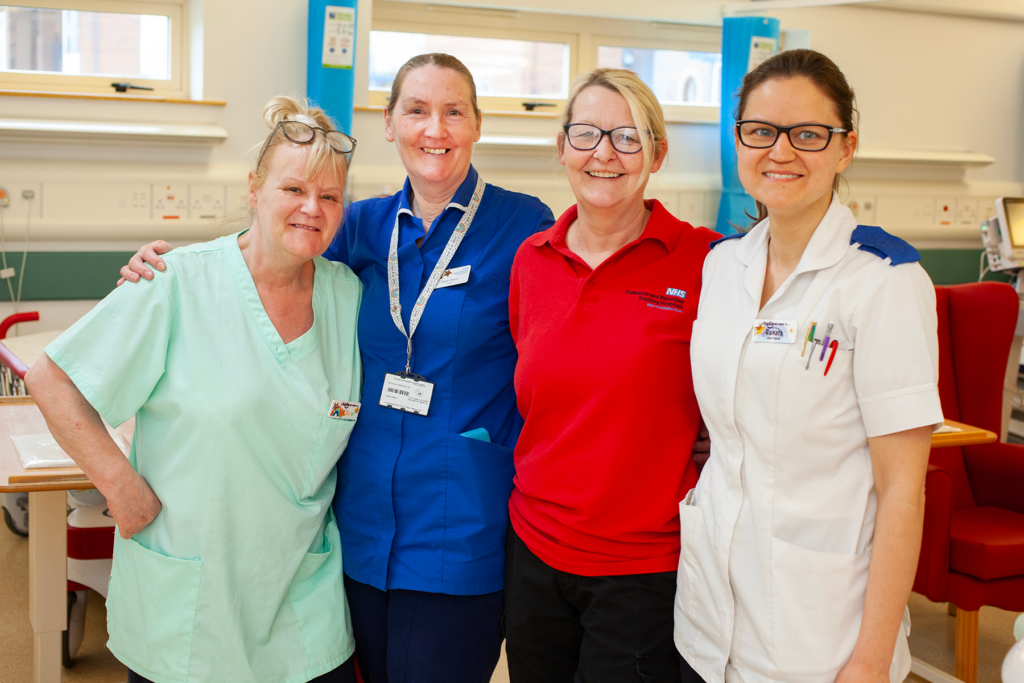
Governance and tracking
There is comprehensive tracking and assurance in place for the delivery of the Digital Enabling Plan:
Board: Finance, Performance, Audit and Risk Committee receive regular updates on digital progress, including our Digital Enabling Plan measures.
Operational leadership and oversight: Trust Leadership Team receive a regular update on digital progress.
Digital assurance: Digital Data and Technology Group receive regular updates and monitor delivery against the delivery themes.
We will make sure we keep our colleagues and patients informed and engaged throughout by:
- Colleague engagement through existing forums and communication methods.
- We will involve our patients, their families and carers through focus groups when developing and designing digital solutions.
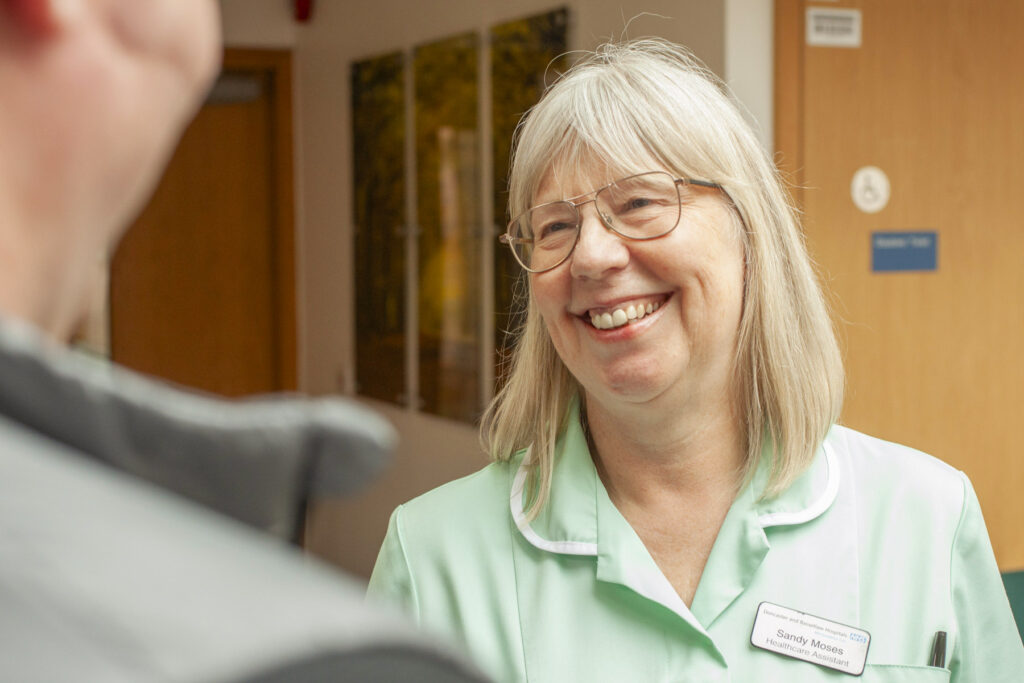
Glossary
Despite our best efforts there may be a number of acronyms in our Digital Enabling Plan.
To help, we have created this handy glossary of terms. Looking for something specific? If you’re on a Windows PC, press CTRL and F together and search.
AAC: Accelerated Access Collaborative
AI: Artificial Intelligence
CAF: Cyber Assessment Framework
CDS: Clinical decision support
CSR
DevOps: software development methodology that combines and automates the work of software development (Dev) and IT operations (Ops)
DQA: Data Quality Assessment
DSPT: Data Security and Protection Toolkit
DTAC: Digital Technology Assessment Criteria
EPR: Electronic Patient Record
FDP: Federated Data Platform
HIMSS: Healthcare Information and Management Systems Society
ICB: Integrated Care Board
ICD-11: Eleventh revision of the International Classification of Diseases
ITIL: Information Technology Infrastructure Library
LIMS: Laboratory Information Management System
NHS: National Health Service
NHSE: National Health Service England
NICE: National Institute for Health and Care Excellence
PAS: Patient Administration System
PRSB: Professional Record Standards Body
PWA: Progressive web app
SDI: Service Desk Institute
SNOMED CT: Systemised Nomenclature of Medicine – Clinical Terms
SUS DQ Dashboards: Secondary Uses Service Data Quality Dashboards
Need this page in another language?
You can view this page in another language using the links below:
Content out of date? Information wrong or not clear enough? Report this page.
